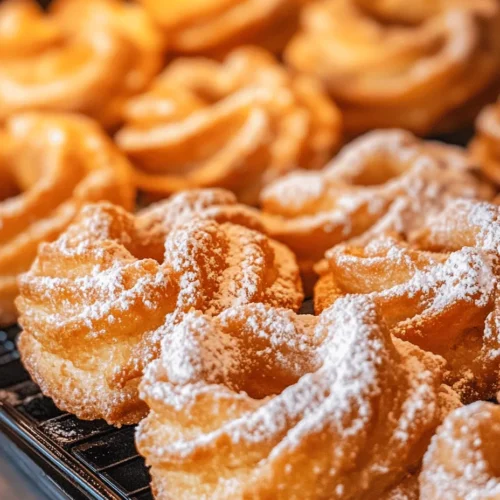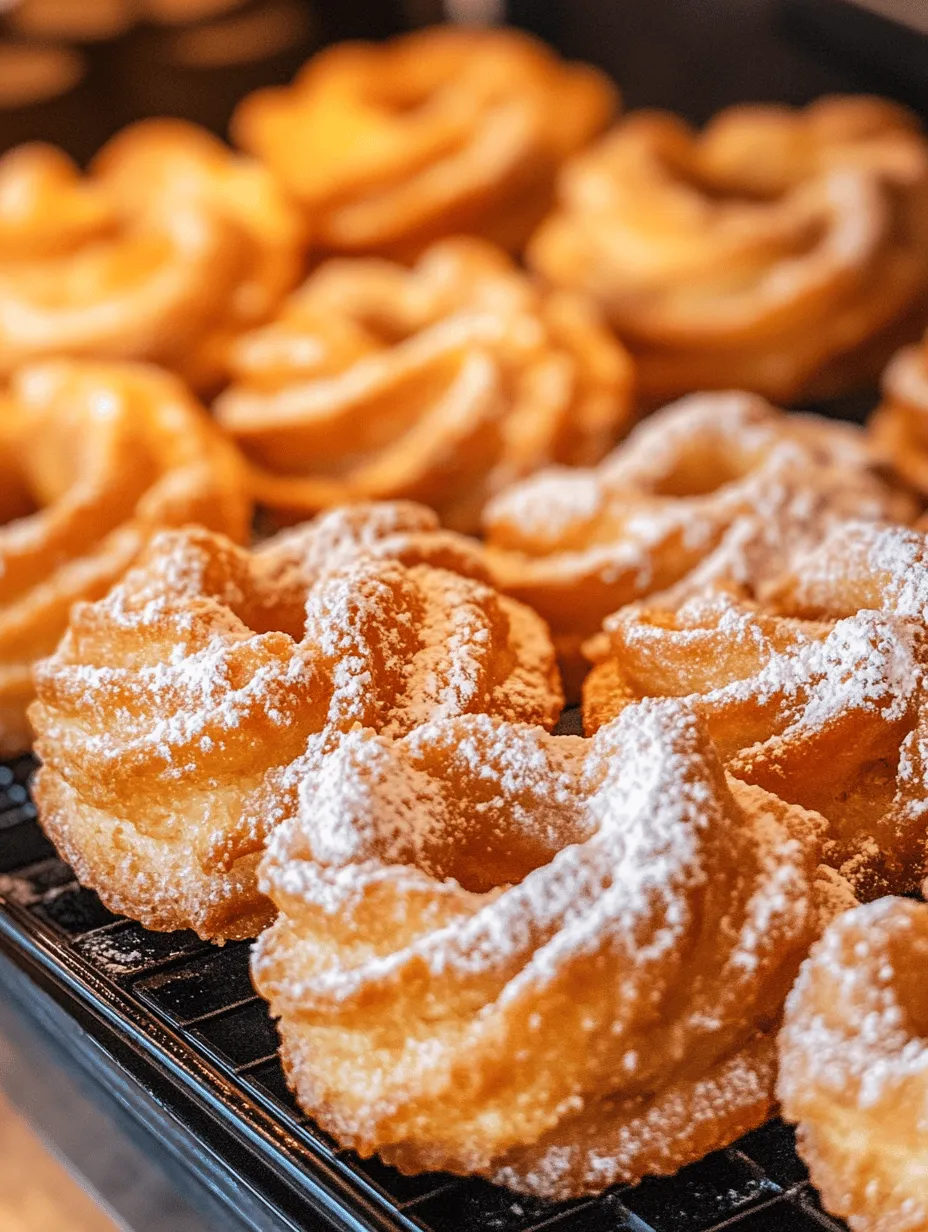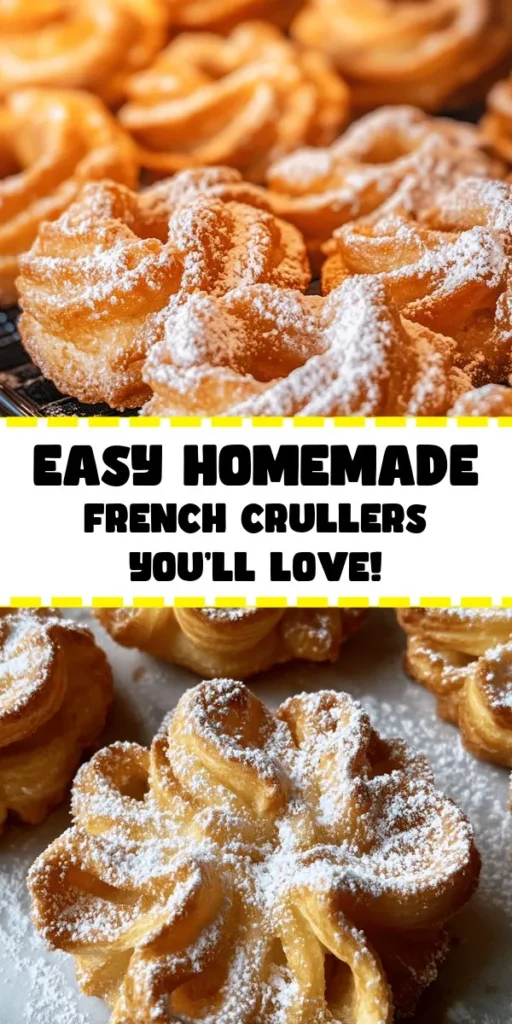Introduction
French crullers are a beloved pastry that encapsulates the essence of French baking—flaky, light, and irresistibly sweet. These delightful treats not only offer a satisfying crunch with each bite but also boast an airy texture that melts in your mouth. Their unique shape, often resembling a twisted ring, and their sweet glaze make them a favorite among pastry enthusiasts and casual snackers alike. Whether enjoyed with a cup of coffee in the morning or as an afternoon indulgence, crullers have a special place in the hearts of many.
Originating from the rich culinary traditions of France, crullers have transcended their humble beginnings to become a staple in bakeries around the world. Their cultural significance is deeply rooted in French cuisine, where they are often associated with celebrations and special occasions. The act of making crullers is not just about baking; it’s an art form that combines technique, patience, and a passion for flavors. In this article, we will guide you through the process of creating these delightful pastries at home, ensuring you can replicate the delectable experience found in the finest patisseries.
The purpose of this article is to provide a comprehensive recipe and guide for making French crullers from scratch. Whether you’re a seasoned baker or a novice in the kitchen, our step-by-step instructions, tips, and ingredient breakdown will equip you with everything you need to impress your friends and family with your homemade crullers.
Understanding French Crullers
What Are Crullers?
Crullers are a type of doughnut that is distinguished by their unique shape and preparation method. Historically, the term “cruller” can be traced back to the Dutch word “kruller,” which refers to something that is curled or twisted. This description perfectly encapsulates the appearance of crullers, which are typically shaped into a spiral or twisted ring. The French version of crullers, often made with pâte à choux (choux pastry), is lighter and airier compared to their yeast-based counterparts.
Historical Background and Origin
The origins of crullers can be linked to European culinary traditions, with variations found across different cultures. In France, crullers evolved as chefs experimented with choux pastry, a dough made from water, flour, butter, and eggs. This pastry is known for its ability to create light and airy textures, making it the ideal base for crullers. Over time, the sweet flavor profile and unique shapes of crullers have made them a popular choice in French bakeries.
Differences Between French Crullers and Other Doughnuts
While crullers may often be grouped with other types of doughnuts, they stand out due to their distinct preparation method. Unlike traditional yeast doughnuts, which rely on fermentation for their rise, French crullers are made using choux pastry. This method involves cooking the dough before baking or frying it, resulting in a unique texture that is both crisp on the outside and soft on the inside. Additionally, crullers are typically glazed with a sweet icing, enhancing their flavor and presentation.
The appeal of crullers extends beyond their texture and taste. Their versatility allows for various flavor adaptations, from classic vanilla to more adventurous options like orange zest or chocolate. This adaptability has cemented crullers as a favorite in both traditional and modern culinary traditions, appealing to a wide range of palates.
Ingredients Breakdown
Creating the perfect French cruller requires a careful selection of ingredients, each playing a vital role in achieving the desired taste and texture. Below is an overview of the key ingredients and their contributions to the final product.
Water
Water is an essential component in the cruller recipe, as it helps to create the dough. It is crucial to use the right amount of water to achieve the perfect consistency in the dough. Additionally, boiling the water with butter and salt creates a rich base that helps to dissolve the ingredients effectively.
Unsalted Butter
Unsalted butter adds richness and flavor to the crullers. It contributes to the overall texture, ensuring that the pastries are both light and tender. Using unsalted butter allows for greater control over the salt content in the recipe, enabling bakers to adjust flavors to their preference.
Salt
Salt is often overlooked in baking, but it plays a critical role in enhancing the overall taste of the crullers. It balances sweetness and elevates the flavors of the other ingredients, ensuring a well-rounded final product.
All-Purpose Flour
All-purpose flour is the foundation of the cruller dough. It provides the necessary structure and stability, allowing the pastries to hold their shape while cooking. The type of flour used can impact the texture of the crullers, so it’s important to select a high-quality flour for the best results.
Eggs
Eggs are essential for providing structure and richness to the crullers. When incorporated into the dough, they create a light and airy texture that is characteristic of French crullers. The protein in the eggs helps to bind the ingredients together, contributing to the overall stability of the dough.
Vanilla Extract vs. Orange Zest
Flavor variations play an important role in personalizing your crullers. Vanilla extract is a classic choice that complements the sweetness of the pastry, while orange zest adds a refreshing citrus note that brightens the overall flavor. Choosing between these two options depends on your personal preference and the flavor profile you wish to achieve.
Oil for Frying
The choice of oil for frying is essential for achieving the perfect cruller. Oils with high smoke points, such as vegetable oil or canola oil, are ideal for frying as they allow for even cooking without imparting unwanted flavors to the pastries. Ensuring the oil is at the correct temperature is crucial to prevent the crullers from absorbing too much oil and to achieve a crispy exterior.
Powdered Sugar
Powdered sugar is the finishing touch for crullers, providing a sweet glaze that enhances their visual appeal. Dusting the crullers with powdered sugar not only adds a touch of sweetness but also creates a beautiful contrast against the golden-brown pastry.
Step-by-Step Instructions
Making French crullers may seem intimidating, but with the right approach and attention to detail, you can create these delightful pastries in your own kitchen. Here, we break down the preparation process into clear, manageable steps to guide you through the journey of crafting the perfect crullers.
Boiling the Water, Butter, and Salt
Begin by gathering your ingredients and measuring them accurately. In a medium saucepan, combine water, unsalted butter, and salt. Place the saucepan over medium heat and bring the mixture to a gentle boil. This step is critical, as it ensures that the butter is completely melted and the ingredients are well combined.
Tip: Keep an eye on the mixture to avoid boiling over. You want the water to boil gently, allowing the butter to melt without creating a mess.
Mixing in the Flour
Once the water, butter, and salt mixture reaches a boil, remove it from the heat and immediately add the all-purpose flour. Stir vigorously with a wooden spoon or spatula until a cohesive dough forms. The dough should pull away from the sides of the saucepan and form a smooth ball.
Tip: This step is crucial for achieving the right consistency. If the dough appears too sticky, return it to low heat for a minute or two to cook off excess moisture.
Incorporating the Eggs
Next, allow the dough to cool slightly before adding the eggs. Incorporate the eggs one at a time, mixing thoroughly after each addition. The dough will initially separate, but as you continue to mix, it will come together and become smooth and glossy.
Tip: Ensure that the eggs are at room temperature before adding them to the dough. This will help them incorporate more easily and contribute to a lighter texture in the final product.
Flavoring the Dough
After the eggs are fully incorporated, add in your choice of flavoring—either vanilla extract or orange zest. Mix until the flavor is evenly distributed throughout the dough.
Tip: For a more intense flavor, consider using a combination of both vanilla extract and orange zest to create a delightful symphony of tastes.
Preparing for Frying
Once the dough is ready, it’s time to prepare for frying. Heat your chosen oil in a deep fryer or a heavy-bottomed pot to a temperature of 350°F (175°C). This temperature is ideal for frying crullers, ensuring they cook evenly and develop that desirable golden-brown exterior.
Tip: Use a candy thermometer to monitor the oil temperature accurately. If the oil is too hot, the crullers may burn on the outside while remaining raw on the inside. Conversely, if the oil is not hot enough, the crullers may absorb excess oil and become greasy.
By following these steps carefully, you will be well on your way to creating delightful French crullers that are sure to impress. In the next part of this article, we will cover the frying process, glazing techniques, and tips for achieving the perfect presentation for your crullers. Stay tuned for more delicious insights into the world of cruller-making!

Cooling the dough before adding eggs is a crucial step in making delightful French crullers. This process allows the dough to stabilize, ensuring the right consistency for piping. When the dough is warm, adding eggs can lead to a runny mixture that is difficult to handle. By allowing the dough to cool, you create a more manageable texture, which helps the crullers hold their shape during frying. This step is essential for achieving that characteristic light and airy structure that makes crullers so irresistible.
Techniques for Piping the Dough
Piping the dough into beautiful shapes is where the artistry of cruller-making comes into play. For best results, use a large star tip (such as a Wilton 1M) attached to a piping bag. This tip will create the signature ridges of a cruller, enhancing its visual appeal and texture.
Here are some tips for piping the dough effectively:
1. Fill the Piping Bag: Fill your piping bag with the cooled dough, ensuring not to overfill it. A half-full bag allows for better control when piping. Twist the top of the bag to push the dough down towards the tip.
2. Practice Your Shape: If you’re new to piping, consider practicing on parchment paper before piping directly into the hot oil. This allows you to get a feel for the pressure needed to create consistent shapes.
3. Piping Technique: Hold the piping bag at a 45-degree angle above the frying oil. Apply steady pressure to the bag while simultaneously lifting it upward to form a ring. Release pressure to break the dough away when the desired length is achieved.
4. Spacing: Leave enough space between the crullers in the frying oil, as they will puff up while cooking. This prevents them from sticking together and ensures even frying.
Frying Tips
Maintaining the oil temperature is crucial for frying crullers. Ideally, the oil should be heated to around 350°F (175°C). If the oil is too hot, the crullers will brown too quickly on the outside while remaining raw inside. Conversely, oil that is too cool will result in greasy, soggy crullers.
To maintain the right temperature, consider using a deep-fry thermometer. Here are additional frying tips:
– Batch Frying: Fry crullers in small batches. This helps maintain the oil’s temperature and ensures even cooking. If the oil temperature drops too much, allow it to return to the desired heat before adding more dough.
– Turning the Crullers: Use a slotted spoon to gently turn the crullers halfway through frying to ensure they cook evenly on both sides. They should take about 3 to 4 minutes to turn a golden brown.
– Testing Doneness: To determine if the crullers are done, look for a golden color and a firm texture. You can also poke one with a toothpick; if it comes out clean, they are ready to be removed from the oil.
Serving Suggestions
When it comes to serving French crullers, presentation is key. Arrange the cooled crullers on a decorative plate, and consider dusting them with powdered sugar for an elegant touch. You can also drizzle them with chocolate glaze or dip them in a simple vanilla icing for added sweetness.
Pairing crullers with beverages enhances the experience. They are delightful alongside a cup of freshly brewed coffee, where the rich flavors complement each other beautifully. Alternatively, a soothing cup of tea or even a glass of cold milk can create a comforting treat.
For those looking to mix things up, consider alternative toppings and flavor variations. A sprinkle of cinnamon sugar adds a warm spice note, while a chocolate glaze can satisfy any sweet tooth. Experimenting with citrus glazes or even a maple syrup topping can introduce exciting new flavors to your cruller experience.
Nutritional Information
Each serving of a French cruller (approximately one cruller) contains roughly:
– Calories: 150-200
– Total Fat: 8-10g
– Saturated Fat: 1-2g
– Cholesterol: 25-30mg
– Sodium: 50-100mg
– Total Carbohydrates: 20-25g
– Dietary Fiber: 0-1g
– Sugars: 5-10g
– Protein: 2-3g
While French crullers are undoubtedly a treat, it’s essential to enjoy them in moderation. They can be a delightful indulgence, especially when shared with family and friends. Remember that balance is key in a healthy diet, and sweet treats like crullers should be enjoyed occasionally.
Cultural Variations of Crullers
Crullers are enjoyed in various forms around the world, each culture adding its unique twist to this beloved pastry. In the United States, crullers are often round with a hole in the center and are frequently glazed or coated in powdered sugar. French crullers, however, are known for their light and airy texture, often featuring a star shape.
In Germany, a similar pastry known as “Kreppel” is a popular carnival treat, typically filled with jam or cream. In the Netherlands, “Dutch crullers” are also enjoyed, characterized by their rich flavor and often served with a dusting of powdered sugar.
Exploring these regional variations can inspire creativity in your own cruller-making process, allowing you to incorporate different flavors and techniques into your recipes.
Common Mistakes to Avoid
Making crullers can be a rewarding endeavor, but there are common pitfalls that can hinder your success:
1. Overmixing the Dough: It’s essential to mix the dough just until combined. Overmixing can lead to a dense texture, which is not ideal for crullers. Aim for a smooth dough that holds together without being tough.
2. Frying at the Wrong Temperature: As mentioned, maintaining the oil temperature is critical. If you notice that the crullers are browning too quickly, reduce the heat. Conversely, if they are not cooking through, increase the temperature slightly.
3. Piping Techniques: Uneven shapes can result from inconsistent pressure on the piping bag. Practice your technique and ensure a steady hand. If necessary, use a template to guide your piping for even shapes.
By avoiding these common mistakes, you’ll set yourself up for a successful cruller-making experience.
Conclusion
Creating French crullers at home can be a joyful and satisfying process. The combination of the light, airy texture with the sweet glaze makes each bite a delight. As you experiment with flavors, shapes, and toppings, you’ll find endless possibilities to share with loved ones.
Baking is not only a culinary skill but also a creative outlet, allowing you to express yourself through flavors and presentations. So, roll up your sleeves, gather your ingredients, and dive into the rewarding world of cruller-making. Whether enjoyed during a casual breakfast or as a special treat with friends, crullers are sure to bring smiles and satisfaction to any occasion.



